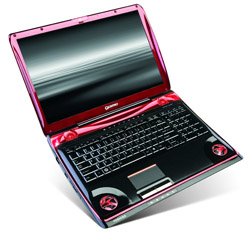More notebooks using two, and now three, GPUs


The Alienware M1 is desktop replacement with a 17-inch display. It starts at only $1,400, but of course if you want all of the good stuff including a quad-core processor, dual-GPUs, a higher resolution (1,920 x 1,200) display, 1TB of storage and Blu-ray, the Alienware M17 can easily break $4,000. CNET's review system fell somewhere in the middle with a 2.26GHz Intel Core 2 Duo P8400, 3GB of DDR3 memory, dual ATI Mobility Radeon HD3870 GPUs, 160GB hard drive and multi-format DVD burner for about $2,000 (the Blu-ray drive is a $30 upgrade). Alienware claims 80% higher frame rates than with a single GPU, and the performance was very good--though not as fast as the $6,000-plus Alienware Area-51 m17x, which has the quad-core CPU and dual Nvidia GeForce 9800M GT. But the Alienware M17's battery life was poor (no surprise there) and the design looks dated.
Toshiba's Qosmio X305 series is also a 17-inch model with a similar range of configurations from $1,550 to $4,200. There are two models with the Nvidia Hybrid SLI configuration. The $2,000 X305-Q708 has a 2.26GHz Intel Core 2 Duo P8400, 4GB of DDR3 memory, the Nvidia GeForce 9400M chipset and two GeForce 9800M GTS GPUs with 1GB of video memory, a 320GB hard drive, and a DVD burner. The $4,200 X305-Q708 adds the 2.53GHz Intel Core 2 Extreme QX9300 quad-core processor and a 128GB SSD, as well as the 320GB hard drive. (Blu-ray isn't an option on Toshiba notebooks.) Both are sold direct, but Toshiba says similar configurations will be available in stores.
Though notebooks based on SLI, and now AMD's CrossFireX, are becoming more common, whether they really make sense is subject to debate. Even on desktops the benefits of multiple GPUs on real-world gaming performance remain uneven. Doubling the number of GPUs in a system doesn't double the performance, but it does require a lot more power. The trade-offs are bigger in laptops in terms of battery life, and size and weight. On top of this, during its WinHEC 20008 conference this week, Microsoft revealed it wouldn't natively support hybrid graphics in Windows 7 with either SLI or CrossFireX because it is too unstable. (The whitepaper, Guidelines for Graphics in Windows 7, has since been pulled from Microsoft's site.)
Ultimately both desktops and notebooks will probably have one or more general CPUs, as well as several co-processors for specific, compute-intensive tasks such as graphics, DVD and high-definition video playback, video transcoding and encryption. The Toshiba Qosmio G55 series with its quad-core SpursEngine co-processor is an early example of this trend, and Intel is clearly headed in this direction with its Larrabee project.